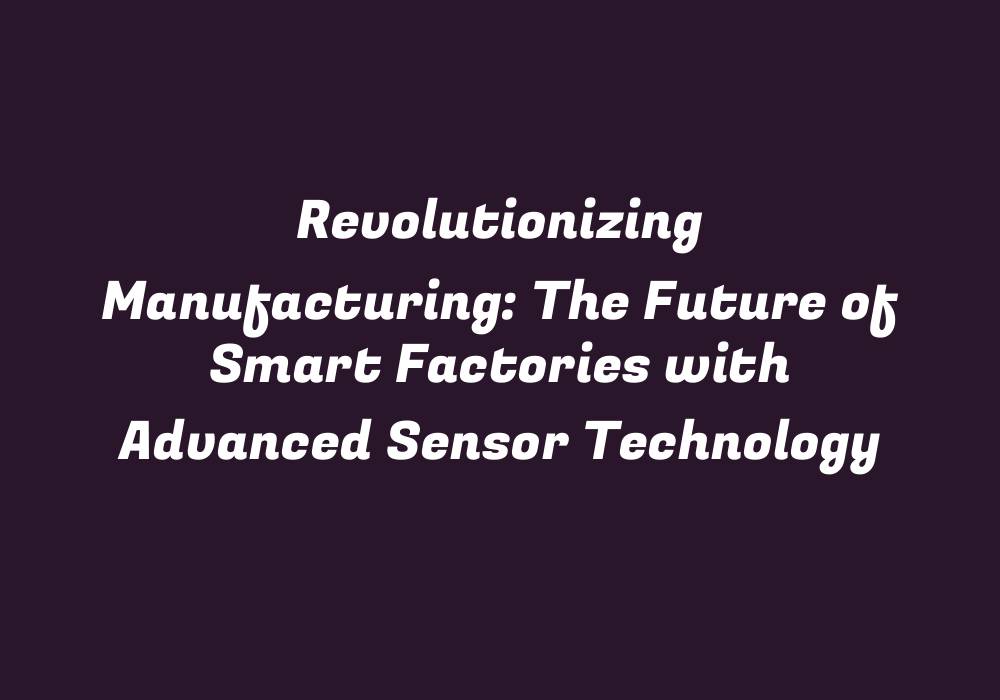Introduction: Shifting Paradigm in Manufacturing with Smart Factories
Technological advancements have always played a crucial role in the growth and development of industries. In recent times, it’s evident that manufacturing industries are undergoing massive transformations due to the introduction of smart factories and advanced sensor technologies. This paradigm shift has significant implications on various facets of the manufacturing sector, including productivity enhancement, cost reductions, and environmental sustainability. Let us delve deeper into this revolutionary trend, its impact on the industry, and what lies ahead in the future of smart factories.
Smart Factories: A Revolutionary Idea
A smart factory is a concept where advanced automation technologies are combined with real-time data collection and analysis to optimize processes across production lines, logistics operations, and maintenance procedures. These next-generation manufacturing facilities operate efficiently by leveraging machine learning algorithms and predictive analytics, thus improving overall operational efficiency.
Advanced Sensor Technology: The Core of Smart Factories
At the heart of smart factories lies advanced sensor technology that enables seamless monitoring, control, and optimization of various processes within a production environment. Sensors are devices which can detect different physical parameters like temperature, pressure, motion, or chemicals in the surroundings. With increased sensing capabilities, these sensors play an important role in providing data-driven insights for decision making and process improvements.
Varieties of Sensor Technologies
Smart factories utilize a wide range of sensor technologies to fulfill their objectives. Some common examples include:
1. Temperature sensors – Measure ambient temperature, monitor heat dissipation in industrial processes, and regulate heating or cooling systems.
2. Pressure sensors – Used for pressure monitoring in pipelines, fluid levels, and process control applications.
3. Motion sensors – Detect movement to enable automated operations and optimize workflow efficiency.
4. Gas sensors – Detect gaseous contaminants like volatile organic compounds (VOCs), harmful chemicals, or toxic gases for health, safety, and environmental concerns.
5. Position sensors – Used in robotic systems for precise control of movement and positioning tasks.
Benefits of Smart Factories in Manufacturing
The integration of advanced sensor technology within smart factories yields significant advantages for the manufacturing industry:
1. Improved Quality Control: Sensors can detect even minor deviations from predetermined process parameters, enabling early identification and rectification of quality issues. As a result, smart factories ensure consistent product quality throughout production runs.
2. Enhanced Safety and Health: Sensor-enabled safety systems can monitor workplace conditions in real-time, thereby reducing potential risks to workers’ health and wellbeing. This also leads to a reduction in the number of accidents and downtime, leading to higher productivity levels.
3. Increased Efficiency and Productivity: Smart factories leverage sensor data for process optimization, minimizing waste, energy consumption, and material usage. This results in improved overall efficiency, leading to cost savings and increased productivity.
4. Streamlined Maintenance and Repair: By continuously monitoring machinery conditions and performance, smart factories can anticipate maintenance needs before any failure occurs, ensuring minimal downtime and maximizing equipment life span.
5. Environmental Sustainability: Smart factories utilize sensor technology to monitor and control energy consumption levels, thereby reducing their environmental impact. They also enable the adoption of sustainable manufacturing practices by optimizing resource usage and minimizing waste generation.
The Future of Smart Factories with Advanced Sensor Technology
As smart factories continue to evolve, it is expected that advanced sensor technology will play a pivotal role in shaping the future of manufacturing. Some areas to watch out for include:
1. Internet of Things (IoT) Integration: The concept of IoT allows various sensors and devices to communicate with each other seamlessly, enabling real-time data exchange across production lines, logistics operations, and even supply chain management systems. This would further enhance the efficiency of smart factories by automating processes and facilitating faster decision-making capabilities.
2. Artificial Intelligence (AI) for Sensor Fusion: The combination of multiple sensor technologies within a single manufacturing environment will require AI to process and analyze vast amounts of data, enabling more intelligent decision-making processes. This would also enable predictive maintenance systems that could anticipate potential equipment failures and optimize production schedules accordingly.
3. Digital Twin Technology: Incorporating digital twin technology into smart factories would allow the creation of virtual representations of physical manufacturing environments, facilitating simulation-based testing and optimization of processes prior to actual implementation. This can significantly reduce risks associated with physical prototypes, streamlining development and improvement cycles.
4. Edge Computing for Data Processing: The ever-increasing amount of sensor data generated in smart factories calls for efficient methods of data processing without burdening centralized cloud systems. Edge computing allows real-time analysis and decision making at the source of data generation, reducing latency and enabling better utilization of resources within the manufacturing environment.
Conclusion: A Brighter Future Awaits Manufacturing with Smart Factories and Advanced Sensor Technologies
As the manufacturing industry continues to evolve, smart factories are poised to revolutionize the way we think about and approach manufacturing processes. With advanced sensor technology at their core, these next-generation facilities promise improvements in efficiency, safety, productivity, and sustainability across all facets of the manufacturing sector. It’s an exciting era for the industry as it embraces this transformational journey toward a brighter, more efficient future.
